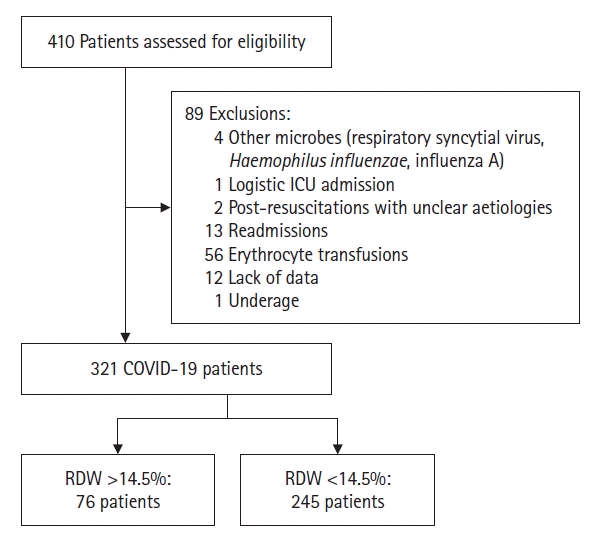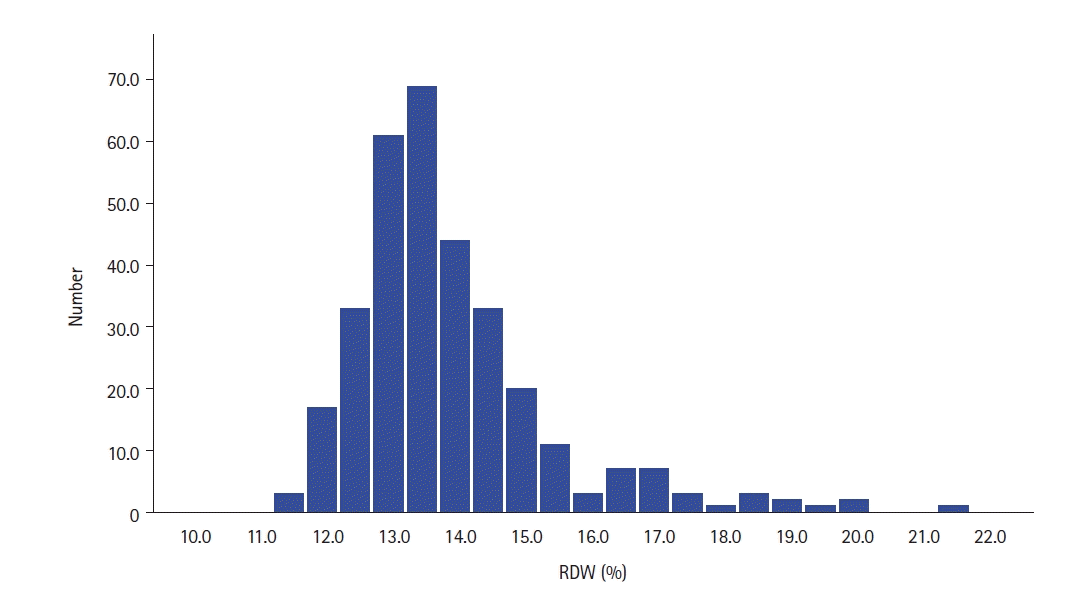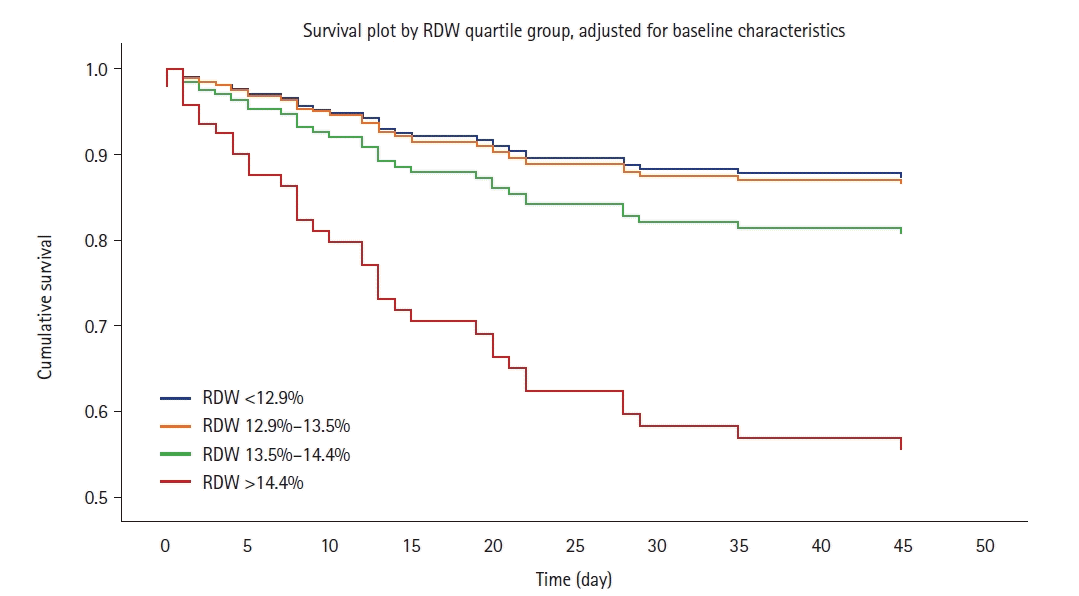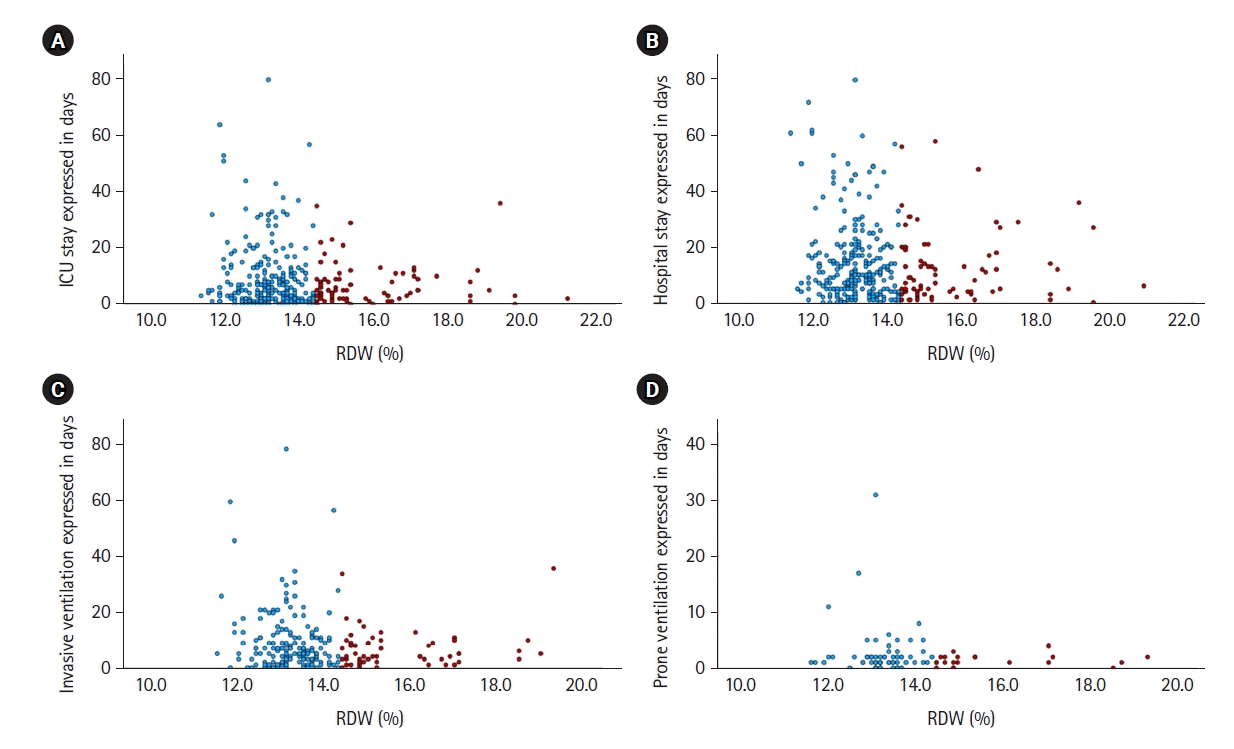1. Li N, Zhou H, Tang Q. Red blood cell distribution width: a novel predictive indicator for cardiovascular and cerebrovascular diseases. Dis Markers. 2017; 2017:7089493.
2. Spadaro S, Taccone FS, Fogagnolo A, Franchi F, Scolletta S, Ragazzi R, et al. The effects of blood transfusion on red blood cell distribution width in critically ill patients: a pilot study. Transfusion. 2018; 58:1863–9.
3. Foy BH, Carlson JC, Reinertsen E, Padros I Valls R, Pallares Lopez R, Palanques-Tost E, et al. Association of red blood cell distribution width with mortality risk in hospitalized adults with SARS-CoV-2 infection. JAMA Netw Open. 2020; 3:e2022058.
4. Jandaghian S, Vaezi A, Manteghinejad A, Nasirian M, Vaseghi G, Haghjooy Javanmard S. Red blood cell distribution width (RDW) as a predictor of in-hospital mortality in COVID-19 patients: a cross sectional study. Arch Acad Emerg Med. 2021; 9:e67.
5. Yu XS, Chen ZQ, Hu YF, Chen JX, Xu WW, Shu J, et al. Red blood cell distribution width is associated with mortality risk in patients with acute respiratory distress syndrome based on the Berlin definition: a propensity score matched cohort study. Heart Lung. 2020; 49:641–5.
6. Wang AY, Ma HP, Kao WF, Tsai SH, Chang CK. Red blood cell distribution width is associated with mortality in elderly patients with sepsis. Am J Emerg Med. 2018; 36:949–53.
7. Dankl D, Rezar R, Mamandipoor B, Zhou Z, Wernly S, Wernly B, et al. Red cell distribution width is independently associated with mortality in sepsis. Med Princ Pract. 2022; 31:187–94.
8. Ghimire R, Shakya YM, Shrestha TM, Neupane RP. The utility of red cell distribution width to predict mortality of septic patients in a tertiary hospital of Nepal. BMC Emerg Med. 2020; 20:43.
9. Tertemiz KC, Ozgen Alpaydin A, Sevinc C, Ellidokuz H, Acara AC, Cimrin A. Could "red cell distribution width" predict COPD severity? Rev Port Pneumol (2006). 2016; 22:196–201.
10. Felker GM, Allen LA, Pocock SJ, Shaw LK, McMurray JJ, Pfeffer MA, et al. Red cell distribution width as a novel prognostic marker in heart failure: data from the CHARM Program and the Duke Databank. J Am Coll Cardiol. 2007; 50:40–7.
11. van Kimmenade RR, Mohammed AA, Uthamalingam S, van der Meer P, Felker GM, Januzzi JL. Red blood cell distribution width and 1-year mortality in acute heart failure. Eur J Heart Fail. 2010; 12:129–36.
12. Bulut O, Akcakaya A, Bulut N, Ovali F. Elevated red cell distribution width as a useful marker in neonatal sepsis. J Pediatr Hematol Oncol. 2021; 43:180–5.
13. Martin SL, Desai S, Nanavati R, Colah RB, Ghosh K, Mukherjee MB. Red cell distribution width and its association with mortality in neonatal sepsis. J Matern Fetal Neonatal Med. 2019; 32:1925–30.
14. Guaní-Guerra E, Torres-Murillo B, Muñoz-Corona C, Rodríguez-Jiménez JC, Macías AE, Scavo-Montes DA, et al. Diagnostic accuracy of the RDW for predicting death in COVID-19. Medicina (Kaunas). 2022; 58:613.
15. Lorente L, Martín MM, Argueso M, Solé-Violán J, Perez A, Marcos Y Ramos JA, et al. Association between red blood cell distribution width and mortality of COVID-19 patients. Anaesth Crit Care Pain Med. 2021; 40:100777.
16. Silva JC, Giraldi T, Coutinho CM, Carvalho Filho MA, Fernandes DC, Santos TM. Reduced physical functional performance before hospitalization predicts life support limitations and mortality in nonsurgical intensive care unit patients. Rev Bras Ter Intensiva. 2022; 34:166–75.
17. Moghimi M, Jozpanahi M, Khodadadi K, Saeed SP, Pirsaraie SV, Jalili N. Red cell distribution width, a predictive factor in immunocompromised patients with COVID-19: a comparison retrospective study between cancer and kidney transplant patients. Eur J Transl Myol. 2022; 32:10582.
18. Henry BM, Benoit JL, Benoit S, Pulvino C, Berger BA, Olivera MH, et al. Red blood cell distribution width (RDW) predicts COVID-19 severity: a prospective, observational study from the Cincinnati SARS-CoV-2 Emergency Department Cohort. Diagnostics (Basel). 2020; 10:618.
19. Hornick A, Tashtish N, Osnard M, Shah B, Bradigan A, Albar Z, et al. Anisocytosis is associated with short-term mortality in COVID-19 and may reflect proinflammatory signature in uninfected ambulatory adults. Pathog Immun. 2020; 5:312–26.
20. Kaufmann CC, Ahmed A, Brunner U, Jäger B, Aicher G, Equiluz-Bruck S, et al. Red cell distribution width upon hospital admission predicts short-term mortality in hospitalized patients with COVID-19: a single-center experience. Front Med (Lausanne). 2021; 8:652707.
21. Sarkar S, Kannan S, Khanna P, Singh AK. Role of red blood cell distribution width, as a prognostic indicator in COVID-19: a systematic review and meta-analysis. Rev Med Virol. 2022; 32:e2264.
22. Ball L, Serpa Neto A, Pelosi P. Obesity and survival in critically ill patients with acute respiratory distress syndrome: a paradox within the paradox. Crit Care. 2017; 21:114.
23. Liu QY, Chen Y, He Y, Zhu RL. Impact of obesity on outcomes in patients with acute respiratory syndrome. J Int Med Res. 2021; 49:3000605211024860.
24. Yeo HJ, Kim TH, Jang JH, Jeon K, Oh DK, Park MH, et al. Obesity paradox and functional outcomes in sepsis: a multicenter prospective study. Crit Care Med. 2023; 51:742–52.
25. Vulturar DM, Crivii CB, Orăsan OH, Palade E, Buzoianu AD, Zehan IG, et al. Obesity impact on SARS-CoV-2 infection: pros and cons "obesity paradox." A systematic review. J Clin Med. 2022; 11:3844.
26. Zhou D, Wang C, Lin Q, Li T. The obesity paradox for survivors of critically ill patients. Crit Care. 2022; 26:198.
27. Zinellu A, Mangoni AA. Red blood cell distribution width, disease severity, and mortality in hospitalized patients with SARS-CoV-2 infection: a systematic review and meta-analysis. J Clin Med. 2021; 10:286.
28. Huang YZ, Kuan CC. Vaccination to reduce severe COVID-19 and mortality in COVID-19 patients: a systematic review and meta-analysis. Eur Rev Med Pharmacol Sci. 2022; 26:1770–6.
29. Jiang Y, Rubin L, Peng T, Liu L, Xing X, Lazarovici P, et al. Cytokine storm in COVID-19: from viral infection to immune responses, diagnosis and therapy. Int J Biol Sci. 2022; 18:459–72.
30. Sanders JG, Spruijt P, van Dijk M, Elberse J, Lambooij MS, Kroese FM, et al. Understanding a national increase in COVID-19 vaccination intention, the Netherlands, November 2020-March 2021. Euro Surveill. 2021; 26:2100792.
31. Pijpers J, van Roon A, van Roekel C, Labuschagne L, Smagge B, Ferreira JA, et al. Determinants of COVID-19 vaccine uptake in the Netherlands: a nationwide registry-based study. Vaccines (Basel). 2023; 11:1409.
32. Verweij M, van de Vathorst S, Schermer M, Willems D, de Vries M. Ethical advice for an intensive care triage protocol in the COVID-19 pandemic: lessons learned from the Netherlands. Public Health Ethics. 2020; 13:157–65.
33. Tang Y, Liu J, Zhang D, Xu Z, Ji J, Wen C. Cytokine storm in COVID-19: the current evidence and treatment strategies. Front Immunol. 2020; 11:1708.
34. Siemieniuk RA, Bartoszko JJ, Zeraatkar D, Kum E, Qasim A, Martinez JP, et al. Drug treatments for covid-19: living systematic review and network meta-analysis. BMJ. 2020; 370:m2980.
35. Prodromos C, Rumschlag T. Hydroxychloroquine is effective, and consistently so when provided early, for COVID-19: a systematic review. New Microbes New Infect. 2020; 38:100776.
36. Paulson RF, Ruan B, Hao S, Chen Y. Stress erythropoiesis is a key inflammatory response. Cells. 2020; 9:634.
37. Wongvibulsin S, Garibaldi BT, Antar AA, Wen J, Wang MC, Gupta A, et al. Development of Severe COVID-19 Adaptive Risk Predictor (SCARP), a calculator to predict severe disease or death in hospitalized patients with COVID-19. Ann Intern Med. 2021; 174:777–85.








 PDF
PDF Citation
Citation Print
Print



 XML Download
XML Download